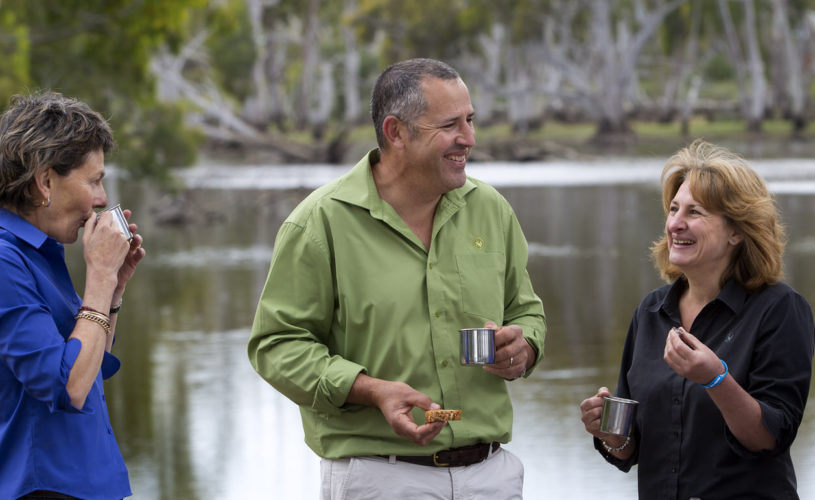Craig Wickham
Craig Wickham is one of Australia’s leading experts on the fauna and flora of Kangaroo Island and he has been sharing Kangaroo Island’s secrets with guests for since 1990.
Please tell us a little bit about who you are and what you do?
I grew up on Kangaroo Island and always had a keen interest in nature and wildlife. I spent a year living and travelling in Africa and studied wildlife and conservation management at University before working as a wildlife ranger with the South Australian National Parks and Wildlife Service. My family has a long history with hospitality and accommodation so the opportunity to work for myself with a professional guiding and tour service provided the chance to blend nature and hospitality.
What got you started with wildlife observation and what do you find most interesting about it?
Growing up with a strong sense of curiosity meant I was constantly observing and learning about the wildlife which surrounded me. Living on a spectacular coastal farm meant there was a constant stream of visitors and I was always keen to show people around and share what I knew. Once I started studying more formally it was clear how little we know about the natural world and guiding provides a chance for continuous learning. One specific element to wildlife observation which intrigues me is wildlife behaviour and habituation – how we are able to amend our behaviour and develop a level of trust in the animals we go to observe. The ability to blend into the background and watch animals doing what they would ordinarily do – not fearfully watching us ready to flee but grooming, joey kangaroos jumping in and out of their mothers’ pouch, or interacting with each other.
How do you bring wildlife observation to life on your tours?
A really positive message to share with our guests is the method by which we develop that habituation – not by providing artificial food sources but by carefully and quietly moving through the landscape and when we see the animals we stop and observe them, and then slowly move closer. Once they start to react we take a step back and sit down. We do not have to be totally silent – the animals will tolerate us speaking at a low volume. Over time this approach distance reduces and the animals start to ignore us – proceeding to feed, lay down to rest and even turn their backs to us, a clear indication that we are no threat to them.
Why do you think it’s important that people learn about wildlife observation?
I think this is a technique which is clearly transferrable and people can take this home and try it with their local wildlife species. It also gives an alternative to feeding which whilst in the short term would meet the objective of animals being habituated, it also rapidly leads to dependance, higher than usual densities which has environmental consequences, and often leads to conflict as animals become more demanding.
If people wanted to find out more about wildlife observation are there any particular books, documentaries or websites you would recommend?
I am unaware of specific books or documentaries relating to wildlife observation through benign habituation but there is plenty of commentary in research articles such as this one which outlines quite a few of the elements of the topic. A couple of favourite wildlife documentaries are: Faces in the mob – summarised in this short clip ; and The Ocean’s Supermum
What’s your favourite Australian animal and why?
The short-beaked echidna – they are incredibly adaptable and flexible – being the most widely distributed native animal in Australia both in terms pf habitat type and climatic range. They are similarly diverse in their behaviour – one echidna will immediately “go to ground” digging into the earth and remaining absolutely still and I have been “out-waited” by echidnas for over 40 minutes! Another will appear very bold – trying to nudge people’s feet out of the way, tipping over camera bags left on the ground and appear to have no fear of people at all. I find it interesting that is a popular culture sense outside of Australia the platypus is very well know as “the egg-laying mammal” yet echidnas are virtually unknown despite being a far more widespread animal.
What place is Australia’s best-kept secret?
A favourite place of mine is Cape Gantheaume on Kangaroo Island’s south coast. Incredibly remote – half a day of walking to get there and I have fixed in my mind a day which held so many elements. White-bellied sea-eagles and ospreys wheeling overhead, Australian sea-lions on the whitest sand beach, thousands of long-nosed fur-seals out on the rocky point to the east and at the base of cliffs lay several long wooden beams – the fractured remains of the masts from the SS You Yangs which wrecked off the coast on Pelorus Islet on 14 June 1890. To me this spot epitomises the diversity of Australia, our wildlife and rugged coast and the powerful natural forces which continue to define our land and our history.
What haven’t you seen / done in Australia that you’d like to and why?
Whew – that is a long list! I am yet to dive with whale sharks at Ningaloo Reef, I would love to explore the extraordinary fossil beds at Riversleigh, I have not visited the Kimberleys and then there are thousands of places I have been once and would love to go back to!
Finally, how can people follow you on social media?
Twitter: @craigwick
Instagram: craig.wickham
Facebook: https://www.facebook.com/exceptional.kangarooisland
Youtube: https://www.youtube.com/user/craigeki
Google+ +CraigWickham
Pinterest craigonki
Click here to find out more about Australian travel with Alquemie

